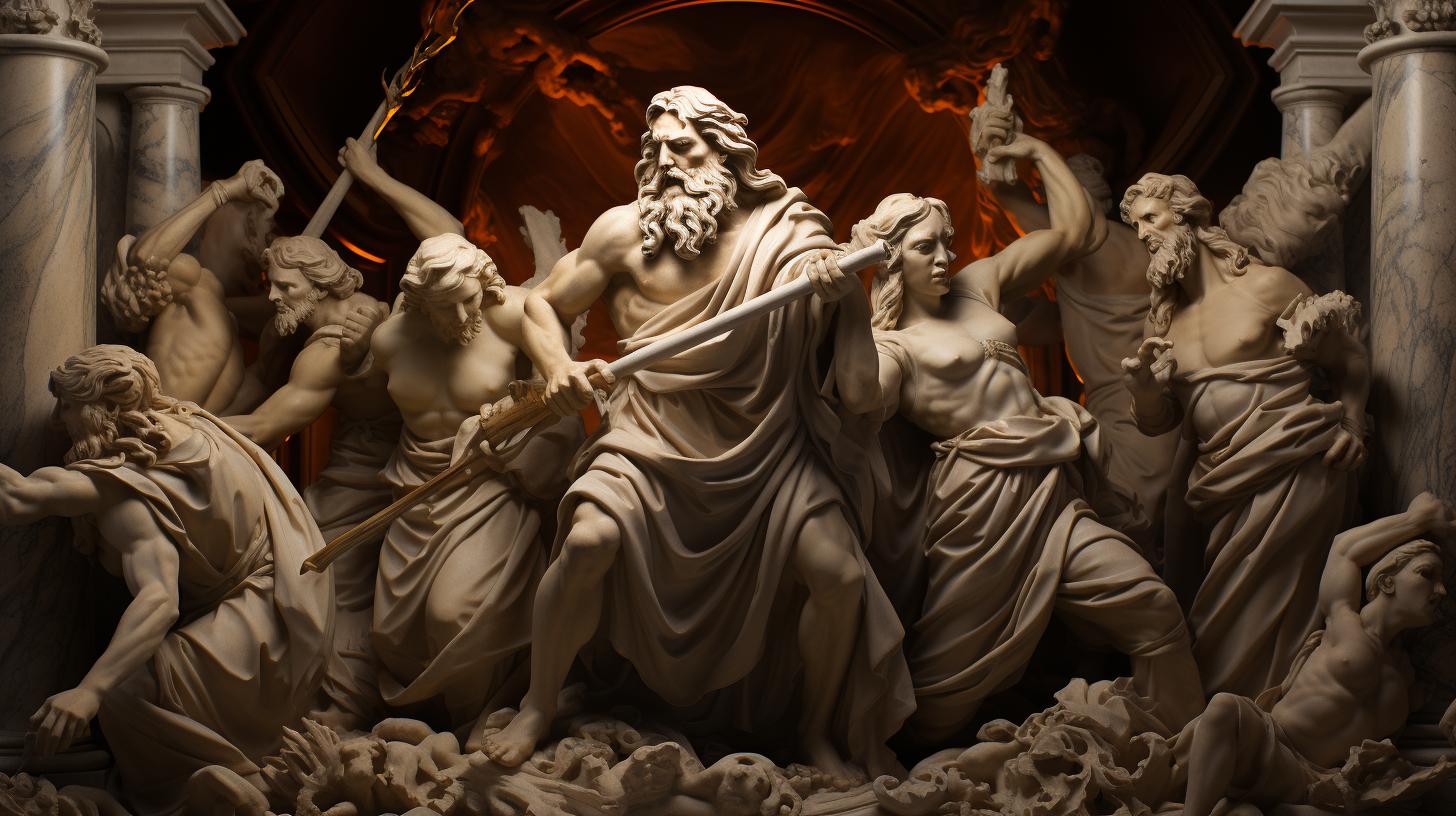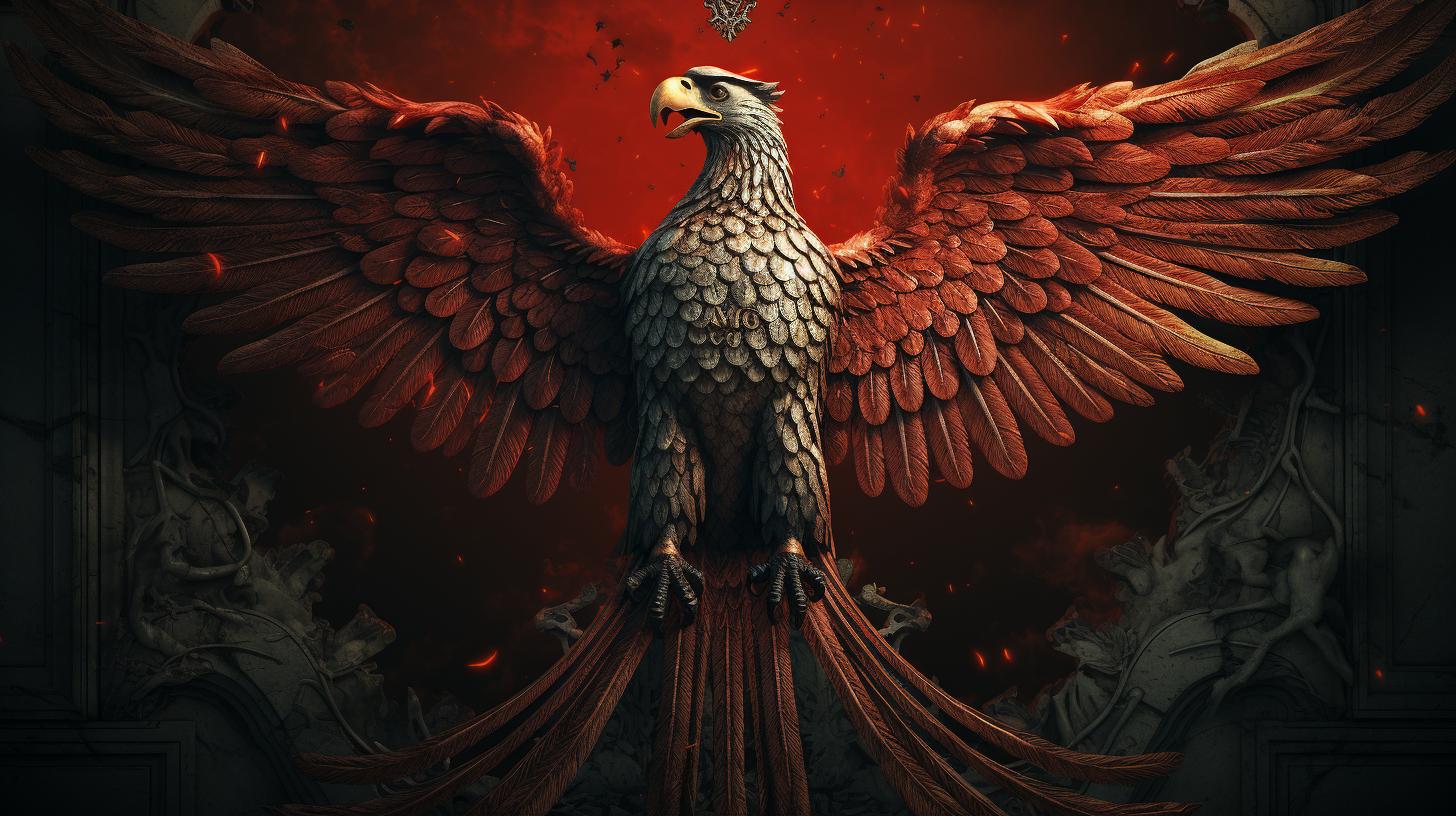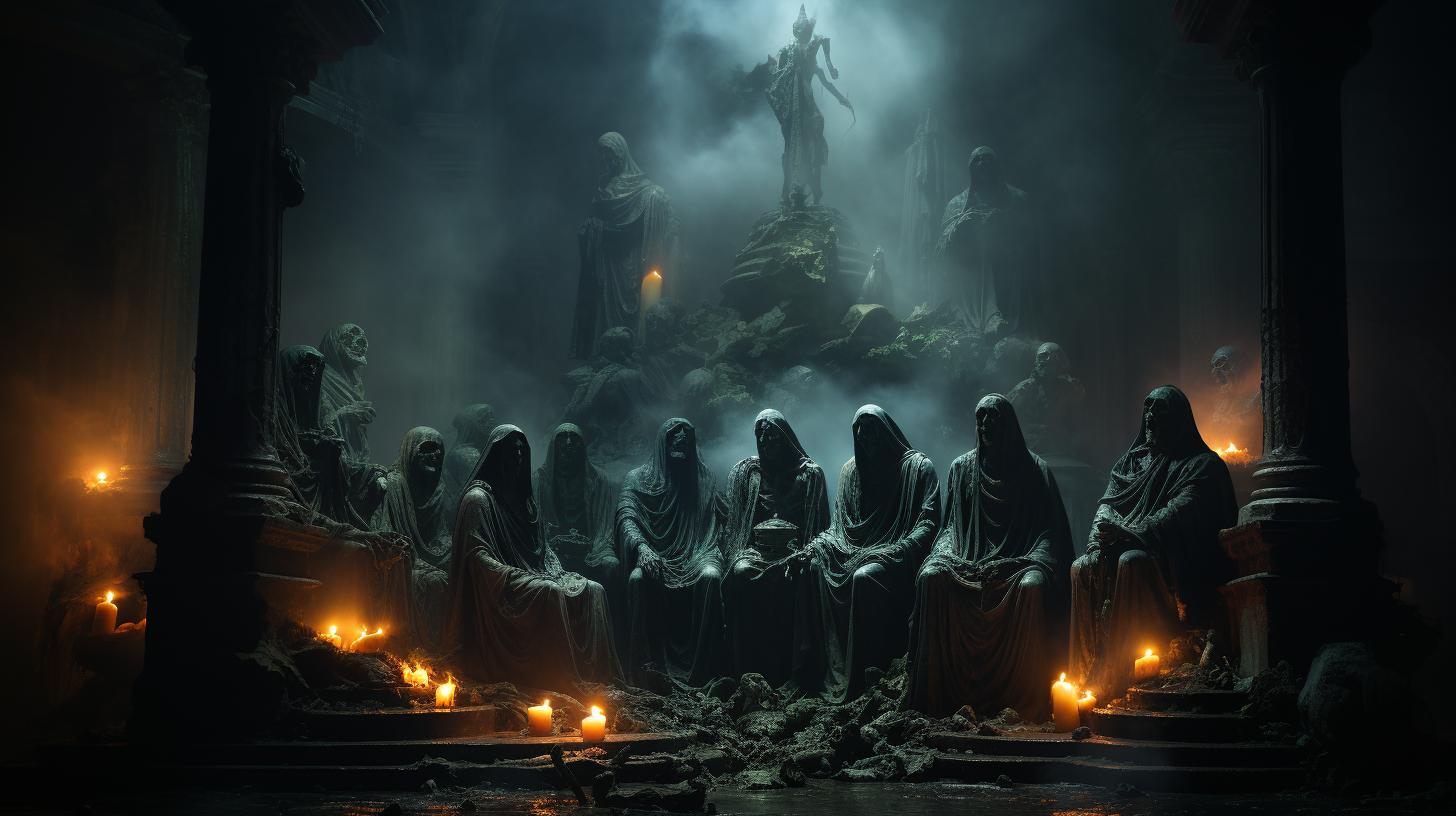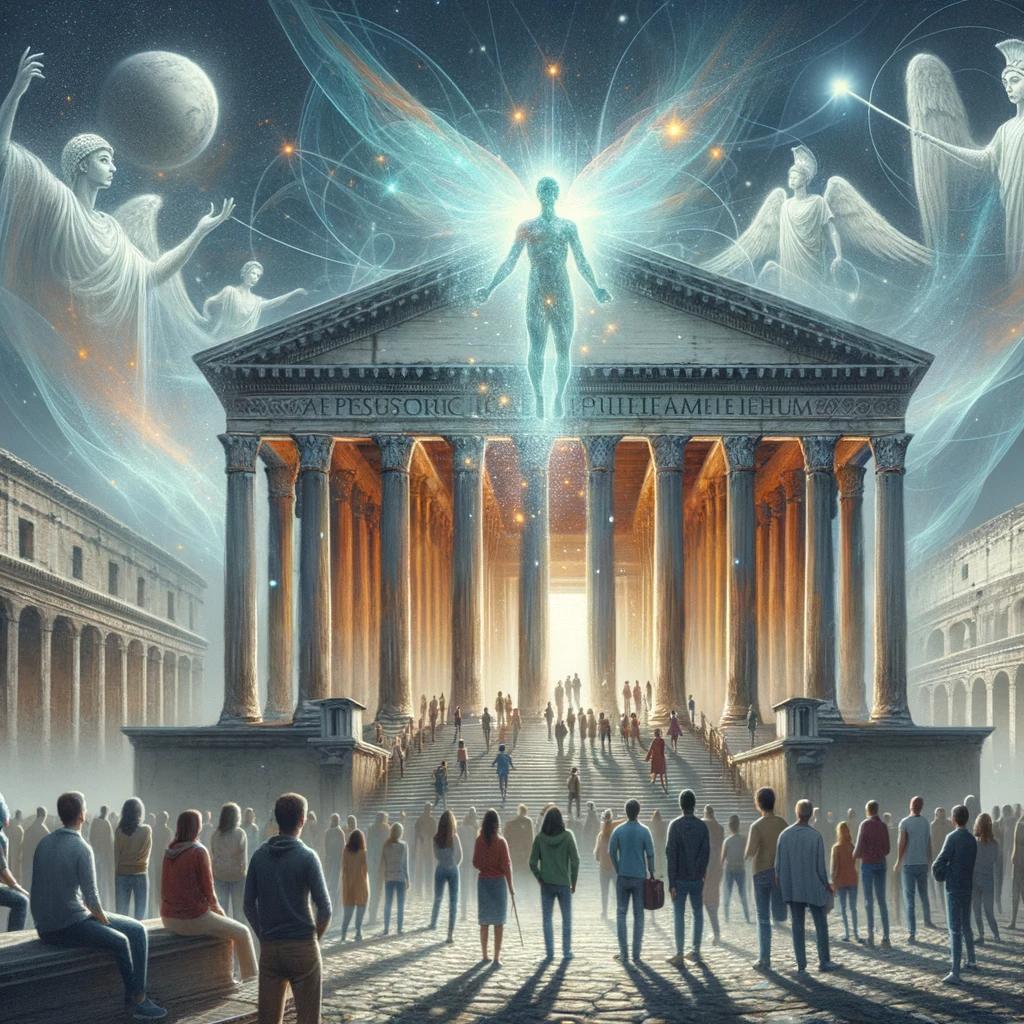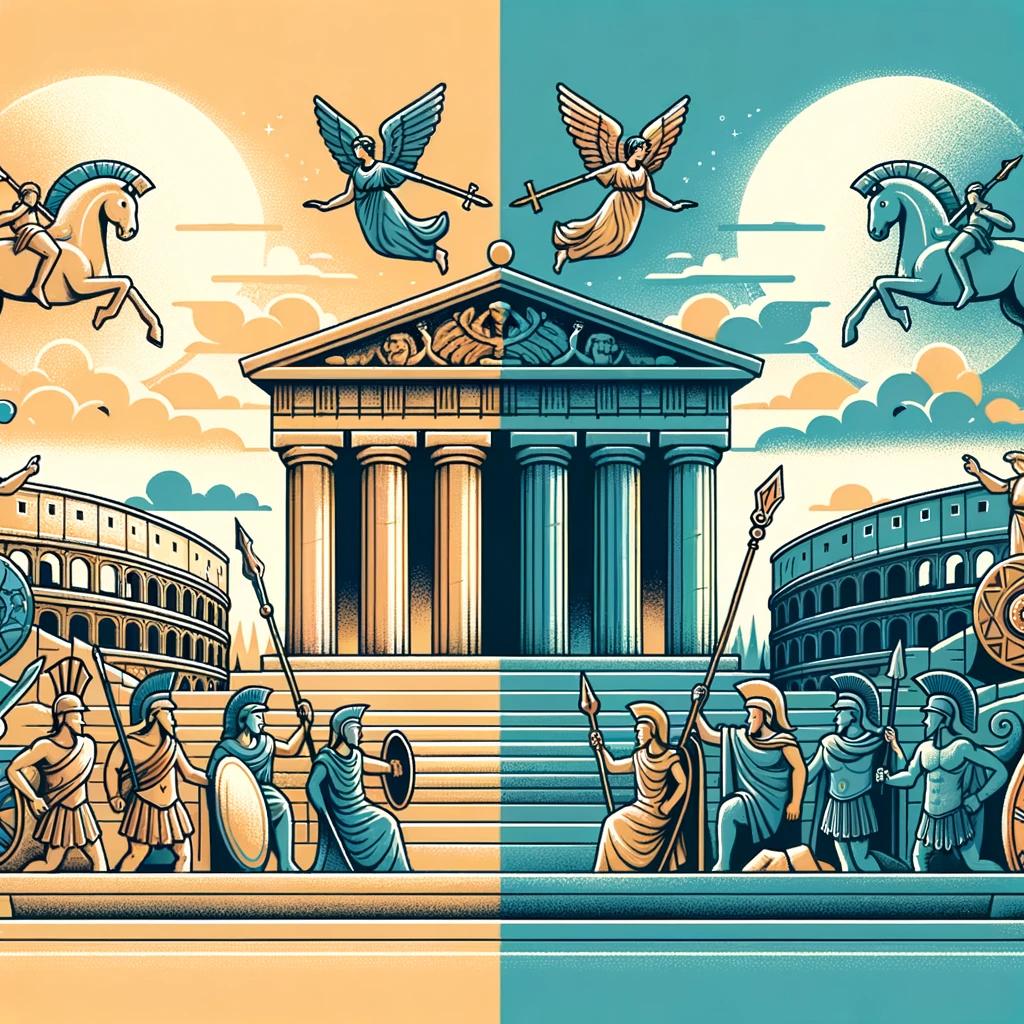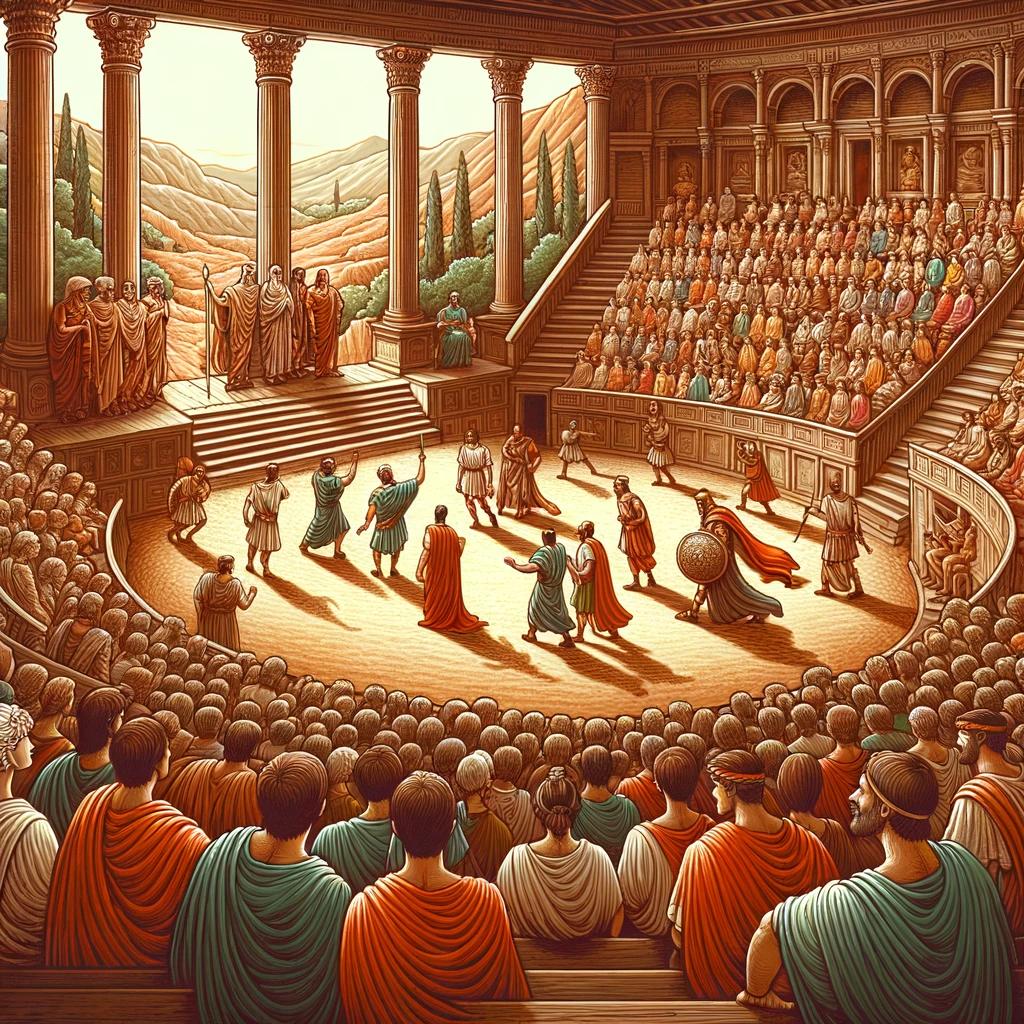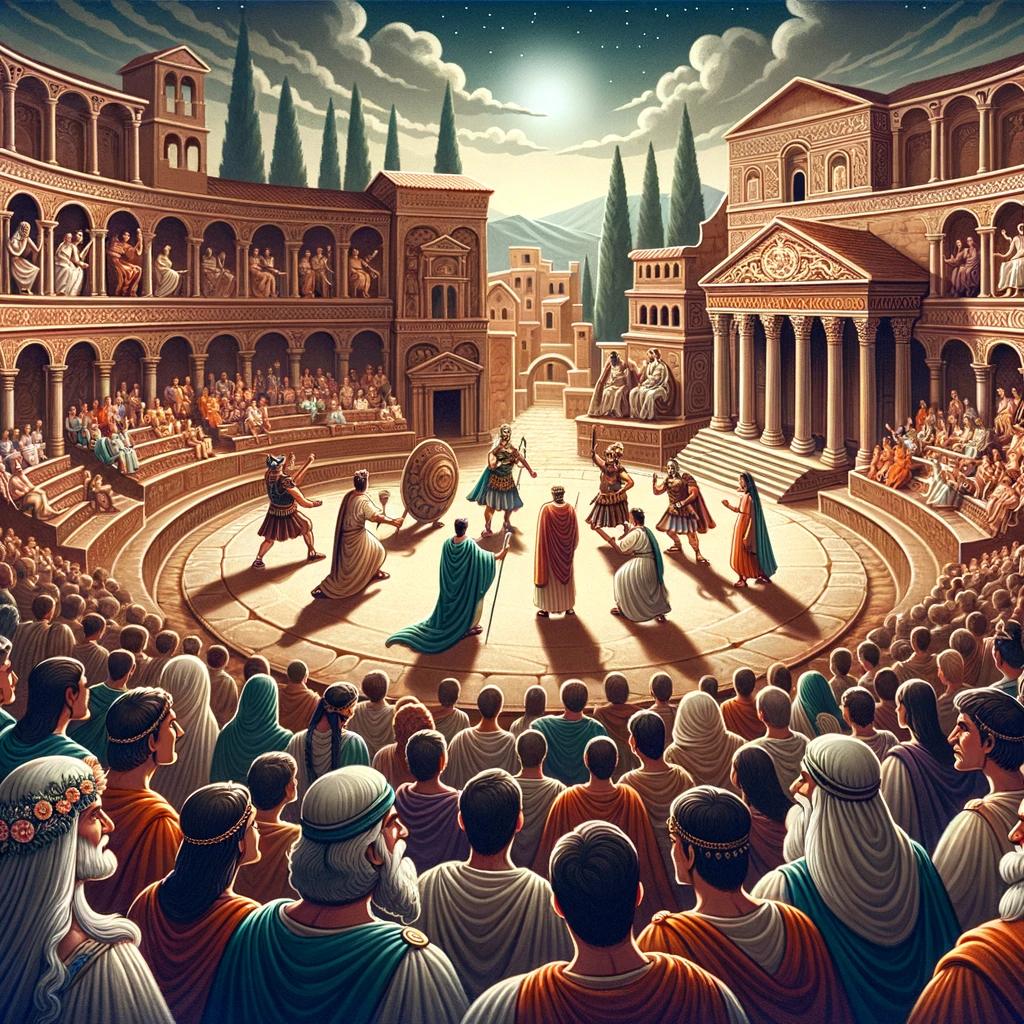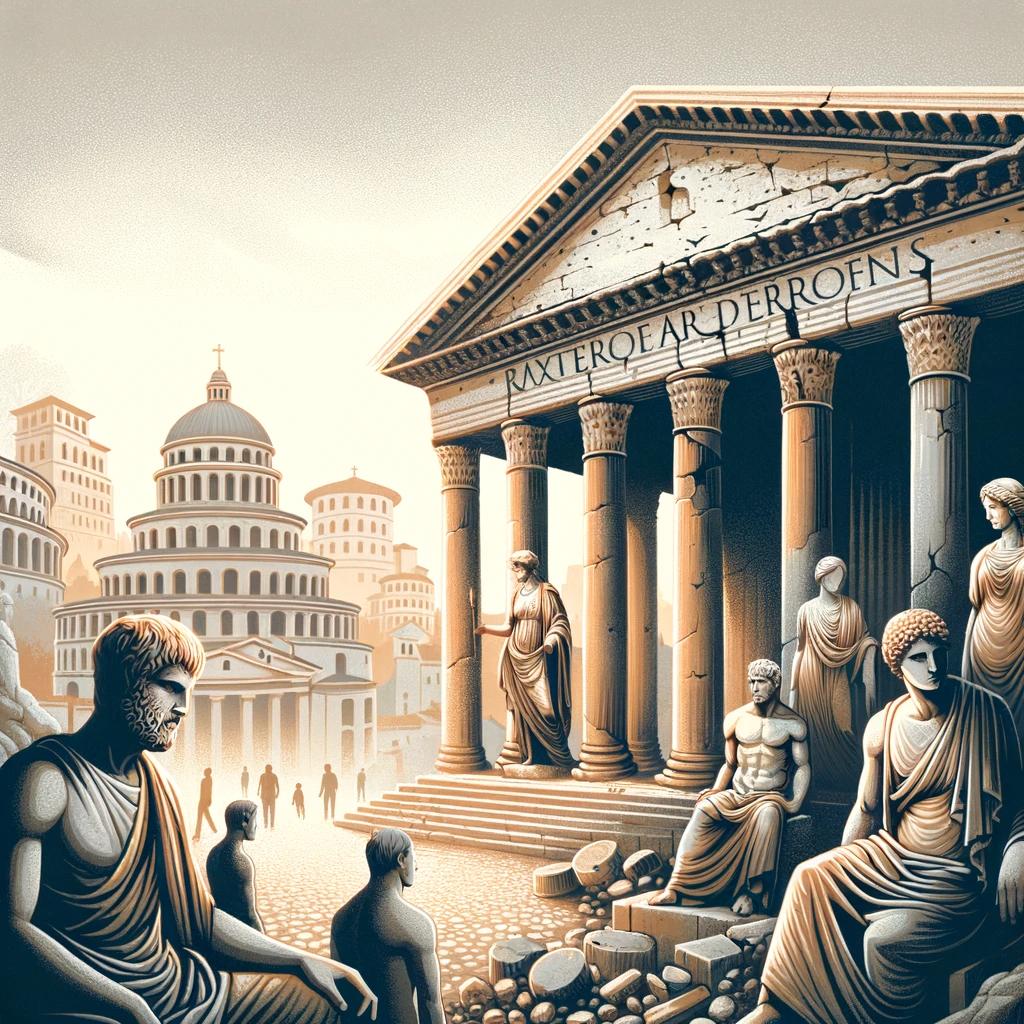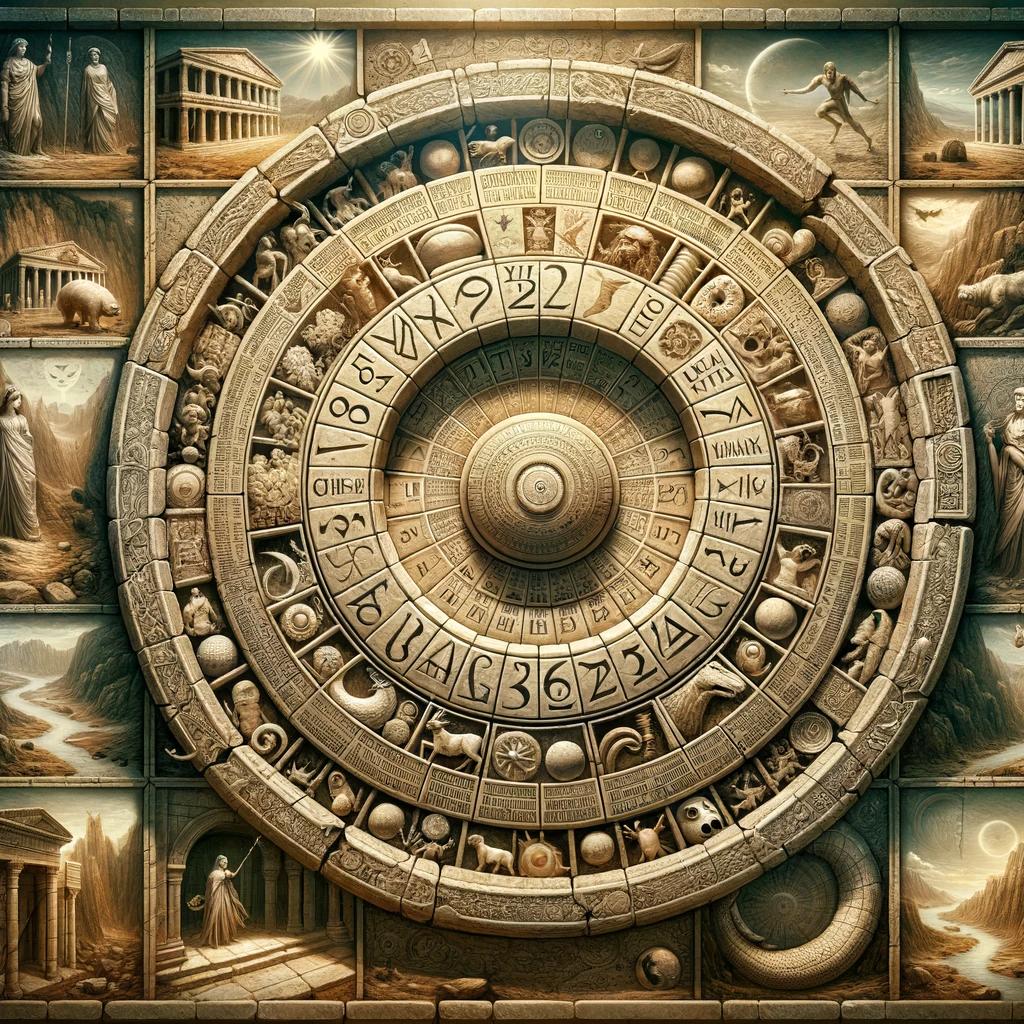Hercules and Cacus: Unraveling the Mythology and Symbolism in American Sculpture
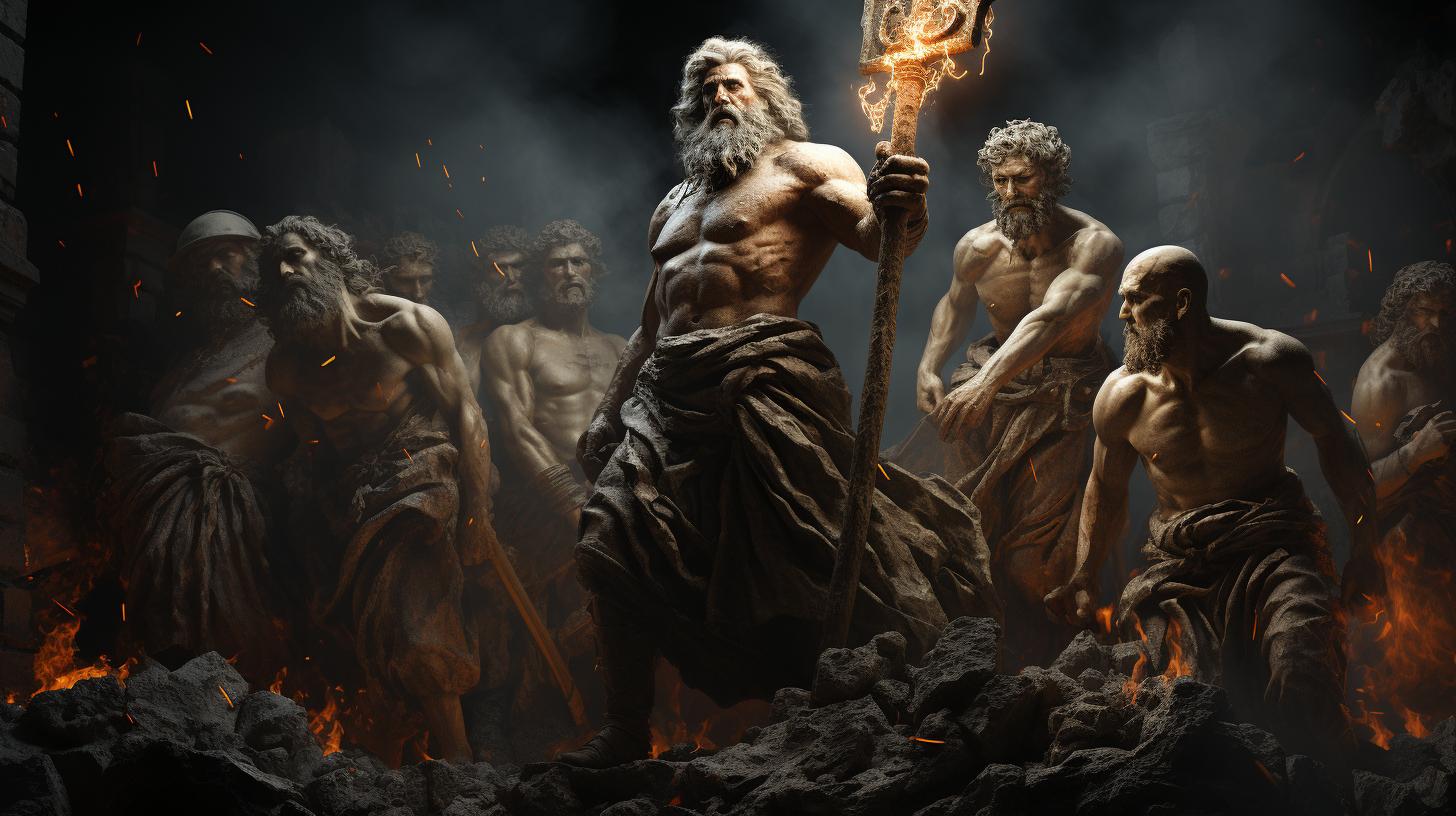
The mythology of Hercules and Cacus is a captivating tale from Roman culture. Hercules, renowned for his strength, encounters Cacus, a villainous creature with ties to fire and theft.
The artistic representation of this story in the Hercules and Cacus sculpture by Baccio Bandinelli showcases the artist’s admiration and rivalry with Michelangelo. This article delves into the symbolism, composition, and historical significance of the sculpture, exploring its connection to self-portraiture and the larger theme of unity in art.
Additionally, it examines the mythological background of Cacus and other interpretations of the sculpture. Recent discoveries and research add further depth to our understanding of this captivating artwork.
The Mythology of Hercules and Cacus
The mythology of Hercules and Cacus is a captivating tale from Roman culture that has inspired various works of art, including the renowned sculpture by Baccio Bandinelli.
This section delves into the story of Hercules and Cacus, examining its origins, key events, and characters.
The Story of Hercules and Cacus
In this mythological narrative, Hercules, a powerful hero known for his incredible strength, encounters Cacus, a fearsome monster dwelling in a cave on the Aventine Hill. Cacus, depicted as a half-human creature with gruesome features, was the son of Vulcan and known for spewing dark fire from his mouth.
Hercules, having just completed one of his twelve labors, embarks on a journey to acquire the cattle of the formidable giant, Geryon. During his travels, he faces opposition from Gerion, his shepherds, and a two-headed dog named Orthrus.
However, the myth takes an intriguing turn when Hercules confronts Cacus near the Aventine Hill in Rome.
Unbeknownst to Hercules, Cacus cunningly steals four bulls and four cows from the cattle while they were grazing and drinking from a nearby river.
Cacus drags the stolen animals by their tails into his cave, attempting to erase any trace of the theft and impede Hercules’ pursuit. The remaining cattle’s mournful cries, however, reveal the treachery.
Upon discovering the theft, Hercules gives chase, and Cacus flees back to his cave, blocking its entrance with an enormous rock. Hercules must find a way to enter the cave but faces the challenge of the massive obstruction.
Symbolism in Hercules and Cacus
The Hercules and Cacus sculpture by Baccio Bandinelli incorporates profound symbolism. While delving into this artwork, we explore the significance of various elements, such as the composition, facial expressions, and the presence of a dead tree trunk nearby.
These symbolic elements shed light on the complex themes and messages portrayed through the artistic representation of Hercules and Cacus.
Hercules and Antaeus: A Comparison
In the Hercules and Cacus sculpture, the depiction of Hercules battling the monstrous Cacus raises comparisons to another mythological encounter – Hercules and Antaeus. Antaeus was a giant and the son of the sea god Poseidon and the earth goddess Gaia. Similar to Cacus, Antaeus presented a formidable opponent for Hercules. However, while Hercules fought Cacus to avenge stolen cattle, his encounter with Antaeus served a different purpose.
Antaeus possessed an extraordinary strength that was derived from his connection to the earth. Whenever he was thrown to the ground, he would renew his vigor and become even stronger. In their battle, Hercules soon realized that he could not defeat Antaeus through conventional means.
Instead, Hercules discovered a strategic approach – lifting Antaeus off the ground. Deprived of his source of power, Antaeus weakened and was eventually defeated.
The comparison between Hercules’ battles against Cacus and Antaeus highlights the diverse challenges he faced and his ability to adapt and find creative solutions.
While Cacus required brute force to overcome, the battle with Antaeus emphasized the importance of intellect and adaptability in overcoming seemingly unbeatable foes.
Hercules Statues: A Historical Overview
Hercules statues have a rich historical significance, spanning across different cultures and time periods. These sculptures depict the legendary figure of Hercules, a hero renowned for his superhuman strength and exceptional feats.
Throughout history, Hercules statues have been created in various styles and materials, reflecting the artistic trends and beliefs of the societies that produced them. From ancient Greece to the Roman Empire and beyond, these statues served as symbols of strength, bravery, and heroism.
Many ancient civilizations sought to honor Hercules through monumental statues, showcasing his mythological exploits and embodying the ideals he represented. These statues often depicted him in a dynamic pose, showcasing his muscular physique and his iconic attributes, such as the lion’s skin and the club.
Over the centuries, Hercules statues have continued to inspire artists and sculptors, with each era leaving its own unique imprint on the portrayal of this legendary figure. From Renaissance masterpieces to contemporary interpretations, these statues provide fascinating insights into the evolving cultural and artistic landscapes.
Today, Hercules statues can be found in museums, public spaces, and private collections worldwide, serving as a testament to the enduring legacy of this mythical hero. Through their artistic beauty and historical significance, these sculptures offer glimpses into the rich tapestry of human imagination and the timeless allure of Hercules as a symbol of strength and heroism.
The Commission and Creation of the Hercules and Cacus Sculpture
The commission for the Hercules and Cacus sculpture was initially intended for Michelangelo, but due to a change in government, the task fell upon Baccio Bandinelli. Bandinelli, an admirer and rival of Michelangelo, was constantly overshadowed by the latter’s talent.
Each figure in the sculpture represents an alternate version of Bandinelli himself, with Hercules’ face resembling the artist.
The creation of the sculpture showcased Bandinelli’s skill and his ability to interpret and depict the story of Hercules and Cacus.
The marble material used for the sculpture added to its grandeur and artistic value.
The influence of Michelangelo on Bandinelli is evident in the composition, with similarities between the Hercules and David sculptures in their postures and expressions of alertness.
The sculpture also features hands that seem ready to strike the stone, capturing the essence of the sculptor’s craft.
Bandinelli’s depiction of himself as Hercules’ own victim reflects his understanding of the unity of beauty and wisdom.
The sculpture symbolizes the pursuit of spiritual happiness in this life, rather than the next, through the comprehension of the creative moment.
While Bandinelli’s sculpture may not rival that of Michelangelo in terms of impressiveness, it showcases his ability to perceive thematic unity in art that often goes unnoticed by the general public.
- Michelangelo originally commissioned, but Baccio Bandinelli took over
- Bandinelli’s self-portrayal in the sculpture
- Influence of Michelangelo on Bandinelli’s composition
- Depiction of hands and craftsmanship in the sculpture
- Bandinelli’s interpretation of unity and spiritual happiness
The Significance of the Marble Material
The use of marble in the Hercules and Cacus sculpture holds great significance in its artistic and historical context.
Marble, with its smooth texture and durability, has been a favored material for sculpture throughout history, particularly during the Renaissance period.
Marble’s association with elegance, beauty, and perfection perfectly suited the representation of these mythological figures.
The use of marble elevates the artistic value of the sculpture and emphasizes the skill and craftsmanship required to create such intricate details.
Moreover, marble possesses symbolic attributes that further enrich the interpretation of the artwork.
In ancient Roman culture, marble was considered a precious and noble material, often associated with divinity and immortality. Its eternal nature reflects the timeless themes and enduring narratives depicted in the mythology of Hercules and Cacus.
- The smoothness of marble highlights the physical prowess and strength of Hercules, while also contrasting with the roughness of the rocky terrain, representing the challenging obstacles that he overcomes.
- Marble’s inherent whiteness represents purity and virtue, aligning with the heroic qualities attributed to Hercules. It conveys the idealized nature of these mythological figures and their larger-than-life personas.
- The cool touch and tactile qualities of marble invite viewers to engage with the sculpture, encouraging a sensory experience that enhances the appreciation of the artwork’s aesthetic and narrative elements.
In essence, the choice of marble as the material for the Hercules and Cacus sculpture not only reflects the artistic preferences of the time but also adds layers of symbolism and visual impact to the portrayal of these legendary figures.
The Influence of Michelangelo on Bandinelli
Bandinelli’s role in the creation of the “Hercules and Cacus” sculpture cannot be understood without considering the influence of Michelangelo, the renowned Italian artist. As one of Michelangelo’s contemporaries, Bandinelli both admired and competed with him, often finding himself overshadowed by Michelangelo’s immense talent.
Inheriting the commission for the sculpture from Michelangelo due to a change in government, Bandinelli took on the challenge of depicting Hercules and Cacus in marble. Interestingly, the face of Hercules in the sculpture bears a resemblance to Bandinelli, leading to speculation that the artist either predicted his own aging appearance or consciously modeled his later self-portraits after this depiction.
Michelangelo’s influence on Bandinelli is evident in the sculpture’s composition, with similarities between “Hercules and Cacus” and Michelangelo’s “David” being particularly noteworthy. Both sculptures feature the figures with their right arms hanging down and their heads turned to the left, displaying alert and furrowed expressions.
This parallel suggests the possibility of self-referentiality and mirrors a process of self-portraiture.
While Bandinelli’s talent may not have reached the same heights as Michelangelo’s, his ability to perceive thematic unity in art, like many artists and poets, sets him apart.
This unity, often overlooked by the general public, holds the key to transcending the limitations of reality and attaining spiritual fulfillment in this life, emphasizing the importance of understanding the interconnectedness of artistic expression.
By examining the influence of Michelangelo on Bandinelli, we gain insights into the artistic choices and self-reflective nature of the “Hercules and Cacus” sculpture, shedding light on the relationship between these two formidable artists of the Renaissance.
The Depiction of Bandinelli in Hercules and Cacus
In the sculpture Hercules and Cacus, Bandinelli’s self-representation is evident through the portrayal of Hercules. The face of Hercules bears a striking resemblance to Bandinelli himself, suggesting that the artist may have envisioned his own appearance in old age or molded his later self-portraits to resemble this image.
This depiction not only reflects Bandinelli’s admiration and rivalry with Michelangelo but also presents him as both the sculptor and the subject.
The sculpture showcases Hercules and David in a similar pose, with their right arms hanging and their heads turned to the left, exhibiting alert expressions and furrowed brows.
Their tense legs are placed on rocky terrain, accompanied by a dead tree trunk nearby. Both figures seem to be sculptors, with their heads appearing as if they are looking into a mirror, engaged in the act of self-portraiture.
- The hands of both Hercules and David are poised to strike the stone, emphasizing their creative process.
- Hercules is sculpting Cacus, while David sculpts himself as a youthful hero and giant.
The sculpture symbolizes Bandinelli as both the artist and the victim, suggesting that beauty and wisdom intertwine opposites.
It implies that through understanding the creative moment, one can attain spiritual happiness in this life rather than the next. While Bandinelli’s sculpture may not possess the same grandeur as Michelangelo’s, the artist, like many others, recognized the thematic unity in art that often goes unnoticed by the general public.
Failure to comprehend this unity could leave one trapped in mere reality.
Analysis of the Sculpture’s Composition
The composition of the Hercules and Cacus sculpture offers fascinating insights into its artistic elements and symbolism. This section explores the similarities between the Hercules and David sculptures, the expressive hands and facial expressions portrayed in the sculpture, and the symbolism of the dead tree trunk.
Similarities between Hercules and David Sculptures
One notable aspect of the composition is the striking resemblance between the Hercules and David sculptures. Both figures are depicted in a similar position, with their right arms hanging and their heads turned towards the left.
This resemblance suggests that both Hercules and David are depicted as sculptors, possibly engaged in self-portraiture.
Hands and Facial Expressions in the Sculpture
The intricate detailing of the hands and facial expressions adds depth to the sculpture’s composition. The hands of both Hercules and Cacus are depicted in a poised position, ready to strike the stone, highlighting their strength and power.
The facial expressions of both figures reveal a sense of alertness and intensity, with furrowed brows conveying a determined focus.
Symbolism of the Dead Tree Trunk
The presence of the dead tree trunk in close proximity to the figures adds symbolism to the composition. The tree trunk, often associated with decay and mortality, serves as a contrasting element against the powerful and immortal figures of Hercules and Cacus.
It represents the ephemeral nature of life and the inevitable passage of time, reminding viewers of their own mortality.
The Concept of Self-Portraiture in Hercules and Cacus
In the sculpture ‘Hercules and Cacus’ by Baccio Bandinelli, there is a fascinating exploration of self-portraiture. The figures of Hercules and David, both represented in the sculpture, are reminiscent of the artist himself, showcasing Bandinelli’s own self-reflective nature.
Both Hercules and David have their heads turned to the left, as if gazing into a mirror. Their right hands are poised to strike, symbolizing the artist’s creative power to shape and mold their respective destinies.
Through the depiction of self-portraiture, Bandinelli creates a connection between the artist and the hero, blurring the boundaries between the mythical and the real.
This exploration of self-portraiture suggests that Bandinelli saw himself as not only the creator but also the subject of his art, projecting his own image onto these heroic figures.
It hints at the artist’s desire to capture his own essence and leave a lasting imprint on his artwork.
- Representation of Bandinelli through Hercules and David
- Symbolic significance of their mirrored gazes
- The artist’s role as both creator and subject
By delving into the concept of self-portraiture, ‘Hercules and Cacus’ offers an intriguing glimpse into Bandinelli’s artistic vision and his desire to intertwine his own identity with that of the heroic figures he sculpted.
The Theme of Unity in Art
The Hercules and Cacus sculpture by Baccio Bandinelli represents more than just a depiction of the mythological characters. It embodies the theme of unity in art, a concept that may go unnoticed by the general public but holds significant meaning for artists and scholars.
By closely examining the composition and symbolism of the sculpture, we can uncover the profound message Bandinelli intended to convey.
In the sculpture, both Hercules and David are portrayed as sculptors, seemingly engaged in a process of self-portraiture.
Their heads turned towards one another, as if gazing into a mirrored reflection, showcasing the connection between the artist and their creation. The powerful stances, with their arms ready to strike the stone, symbolize the transformative journey of artistic creation.
Through the depiction of Bandinelli as Hercules, the sculptor presents himself as both the creator and the victim of his art. This representation captures the essence of unity, where beauty and wisdom intertwine, and opposites merge.
Bandinelli’s portrayal of himself in the sculpture suggests that true artistic expression can lead to spiritual fulfillment in the present, rather than in some distant future.
While Bandinelli’s sculpture may not possess the awe-inspiring impact of Michelangelo’s works, it offers a unique perspective on the theme of unity in art.
To fully appreciate and comprehend this unity, one must move beyond surface appearances and delve into the depths of artistic expression. Failure to perceive this unity may result in being trapped within the confines of mundane reality.
With its profound symbolism and exploration of artistic unity, the Hercules and Cacus sculpture by Baccio Bandinelli offers a thought-provoking insight into the power and transformative nature of art.
The Mythology of Cacus in Roman Culture
Cacus holds a prominent place in Roman mythology as a fearsome and monstrous figure.
Son of Vulcan, the god of fire and metalworking, Cacus possessed physical features that mirrored his dark and menacing nature. He was described as a half-human monster with repulsive traits, dwelling in a cave on the Aventine Hill.
Not only was Cacus monstrous in appearance, but his behavior was equally malevolent. His cave was adorned with the heads of men, and its warmth came from the recently spilled blood.
The local people lived in fear of Cacus, praying for someone to end his reign of terror.
It was during this time that Hercules, embarking on his challenging quests following the tragedy of his family, arrived in Rome.
Having just completed one of his twelve labors, he traveled with the stolen cattle of the giant monster Gerion. Unbeknownst to Hercules, Cacus had stolen four bulls and four cows from the herd, cleverly attempting to conceal their tracks.
When the remaining cattle left the grazing area, their mournful cries exposed Cacus’ theft. Determined to retrieve what was stolen, Hercules pursued Cacus to his cave. However, Cacus blocked the entrance with a massive rock, presenting Hercules with a formidable challenge.
What followed was an epic battle, as Hercules fought against Cacus to save the stolen cattle and free the local people from their torment. This clash between Hercules and Cacus represented the triumph of good over evil, valor over fear.
The mythology of Cacus serves as a testament to the Roman reverence for heroism and the struggle against tyranny. It embodies the eternal struggle between light and darkness, virtue and vice, capturing the imagination of generations and weaving itself into the tapestry of Roman culture.
The Role of Cacus as the Villain in the Story
In the mythology of Hercules and Cacus, Cacus plays a significant role as the antagonist and villain of the story. Cacus, a monstrous half-human creature, was known for his unpleasant physical appearance and savage behavior.
Living in a cave on the Aventine Hill, Cacus was the son of Vulcan and possessed the ability to breathe out his father’s black fire.
Not only did Cacus display monstrous traits in his form, but he also exhibited cruelty in his actions.
His lair was constantly warm with the recently spilled blood and adorned with the severed heads of men. The local people, enduring his reign of terror, prayed for someone to end Cacus’ atrocities.
Responding to their prayers, Hercules arrived at the scene after completing one of his twelve labors. His tenth labor involved acquiring the cattle of the fearsome giant, Geryon, on the island of Erytheia.
However, during Hercules’ travels, Cacus cunningly stole four bulls and four cows from the herd, dragging them by their tails into his cave to conceal his tracks.
When the remaining cattle left the pasture, they mournfully mooed, revealing the theft committed by Cacus.
Discovering the robbery, Hercules pursued Cacus, who fled back to his cave and blocked the entrance with an enormous rock. Hercules faced the challenge of finding a way to enter the cave and confront Cacus.
This conflict between Hercules and Cacus forms the climax of the story, showcasing Hercules’ strength and overcoming the monstrous villain. Through his bravery and determination, Hercules ultimately defeated Cacus, putting an end to his reign of terror and restoring peace to the local community.
Hercules’ Encounter with Cacus during his Travels
As Hercules made his way back with the stolen cattle from the terrifying giant Gerion, he unknowingly crossed paths with Cacus on the Aventine Hill in Rome. Cacus, a half-human monster with unpleasant features, had previously stolen four bulls and four cows from Hercules’ herd.
Cacus cunningly dragged the stolen animals by their tails into his cave, attempting to cover his tracks and prevent Hercules from discovering the theft. However, the rest of the cattle, as they left the pasture, emitted mournful cries, exposing Cacus’ misdeed.
Upon uncovering the robbery, Hercules pursued Cacus, who quickly fled back to his cave and blocked the entrance with an enormous rock. Hercules, determined to enter the cave and confront Cacus, faced the challenge of the obstructing rock.
In a fierce battle of strength and strategy, Hercules eventually defeated Cacus, ending his reign of terror on the Aventine Hill. This encounter marked one of the legendary adventures in Hercules’ eventful journeys, showcasing his valor and determination as he continued to fulfill his quests.
This confrontation with Cacus not only showcases Hercules’ bravery but also symbolizes the victory of good over evil, highlighting the prevailing themes of heroism and justice within the Hercules and Cacus mythology.
The Battle and Defeat of Cacus by Hercules
During his travels to complete his Twelve Labors, Hercules encountered the menacing figure of Cacus, a monstrous half-human creature. The battle between Hercules and Cacus ensued as the hero sought to bring an end to the reign of terror inflicted by this vile creature.
Hercules, fueled by his strength and determination, faced the devious tactics employed by Cacus. Despite the monster’s attempts to hide his stolen livestock and hinder Hercules’ pursuit, the hero’s unwavering resolve led him to uncover Cacus’ deceit.
In a display of power and valor, Hercules engaged in a fierce combat with Cacus. The battle was intense, with the clashing of mighty blows echoing through the air. But in the end, Hercules emerged victorious, defeating Cacus and restoring peace to the land.
This pivotal event in the mythological tale of Hercules and Cacus showcases the hero’s indomitable spirit and his commitment to vanquishing evil. It symbolizes the triumph of righteousness over malevolence, reminding us of the eternal struggle between light and darkness.
The epic battle between Hercules and Cacus serves as a testament to the hero’s legendary status and his unwavering dedication to protecting innocent lives. It is an enduring tale of heroism that continues to captivate audiences, leaving a profound impact on our understanding of ancient mythology.
- Engagement in fierce combat
- Hercules’ unwavering resolve
- Defeat of Cacus and restoration of peace
- Symbolism of righteousness triumphing over malevolence
- Enduring tale of heroism
Other Interpretations of the Hercules and Cacus Sculpture
Throughout history, the Hercules and Cacus sculpture has sparked various interpretations and debates among art enthusiasts.
Some alternative interpretations suggest a deeper symbolism hidden within the artwork.
One interpretation proposes that the sculpture represents the eternal struggle between good and evil. Hercules, embodying the virtuous hero, is depicted overpowering the monstrous Cacus, symbolizing the triumph of righteousness over wickedness.
Another viewpoint suggests that the sculpture serves as a commentary on power dynamics. Hercules, as a representation of strength and might, represents the ruling class, while Cacus represents the oppressed and marginalized.
This interpretation highlights themes of injustice and resistance.
Furthermore, some scholars speculate that the sculpture can be seen as a representation of artistic rivalry and self-expression. The similarities between Hercules and David sculptures, as well as the emphasis on self-portraiture, suggest a reflection on the artist’s own struggles and ambitions.
These alternative interpretations provoke contemplation about the complex layers of meaning within the Hercules and Cacus sculpture, inviting viewers to explore beyond the surface narrative and engage with the deeper symbolisms conveyed by the artwork.
Similarities with the Samson and Philistine Sculpture
The Hercules and Cacus sculpture shares striking similarities with the Samson and Philistine sculpture, adding to its intrigue and artistic exploration. Although both sculptures have been subject to different interpretations, the parallel elements are evident in their composition and symbolism.
Like Hercules, Samson is depicted in a position of strength and power, standing over his defeated opponent. Both sculptures convey dynamic movement, capturing the intensity and struggle of the moment.
The facial expressions of both Hercules and Samson exhibit determination and concentration, emphasizing their heroic nature.
In terms of symbolism, the sculptures signify the triumph of good over evil. Both Hercules and Samson represent legendary figures who use their exceptional abilities to defeat formidable adversaries.
The sculptures portray the inherent noble qualities of these heroes, resonating with themes of heroism and valor.
- The composition of both sculptures highlights the physical prowess and muscularity of the protagonists, underscoring their legendary strength.
- Their decisive gestures and facial expressions reveal a sense of purpose and determination, capturing the essence of their heroic acts.
- Although the specific context and stories differ between Hercules and Samson, the sculptures symbolize the triumph of righteousness over tyranny.
The similarities between the Hercules and Cacus sculpture and the Samson and Philistine sculpture provide further insight into the artist’s exploration of heroism and the struggle against adversity across different mythologies and cultures.
Recent Discoveries and Research on Hercules and Cacus Sculpture
Recent studies and discoveries have shed new light on the Hercules and Cacus sculpture, offering fresh insights into its artistic and historical significance. Researchers have delved into the composition, symbolism, and cultural context of this captivating artwork.
One notable finding is the potential connection between the Hercules and Cacus sculpture and another similar piece known as the Samson and Philistine sculpture. Scholars have drawn parallels between the two, noting similarities in their themes and artistic elements.
Additionally, a sculpture auctioned at Sotheby’s in 2014 is believed to be part of the same group as the Hercules and Cacus artwork. This discovery raises intriguing questions about the wider collection and its original purpose.
These recent research endeavors have sparked renewed interest in the Hercules and Cacus sculpture, as academics and art enthusiasts strive to uncover its hidden meanings and explore its place within the broader artistic landscape of the time.
With ongoing studies and further investigations, our understanding of the Hercules and Cacus sculpture continues to evolve, unearthing fascinating details that enrich our appreciation of this remarkable masterpiece.
.











